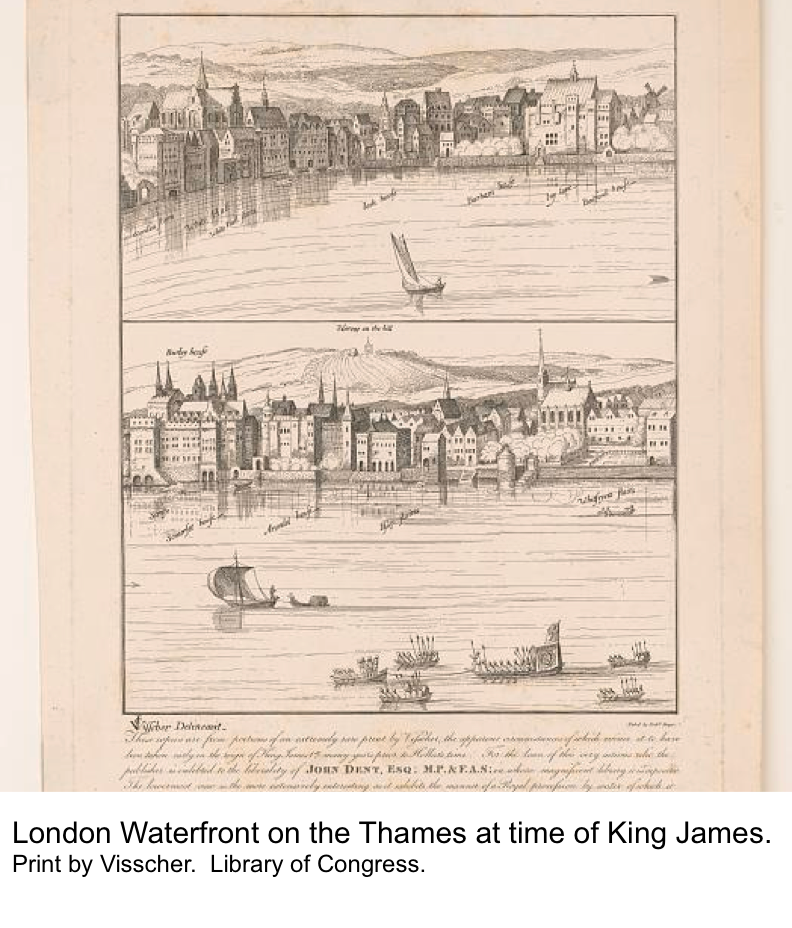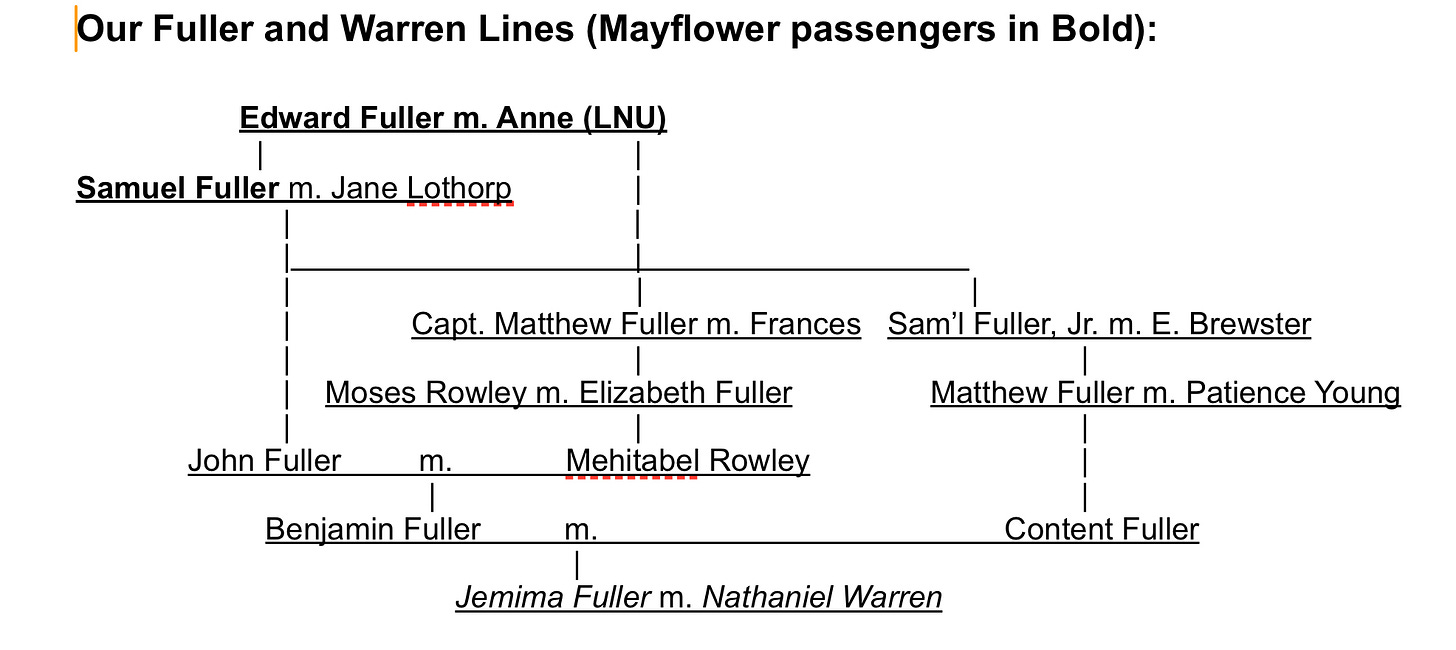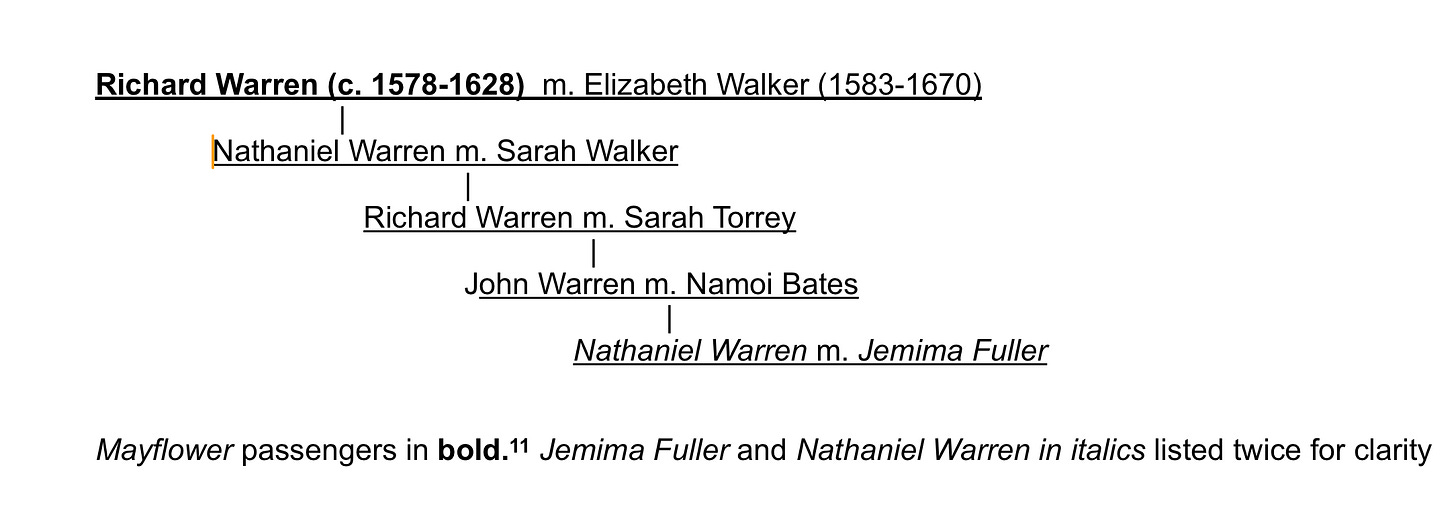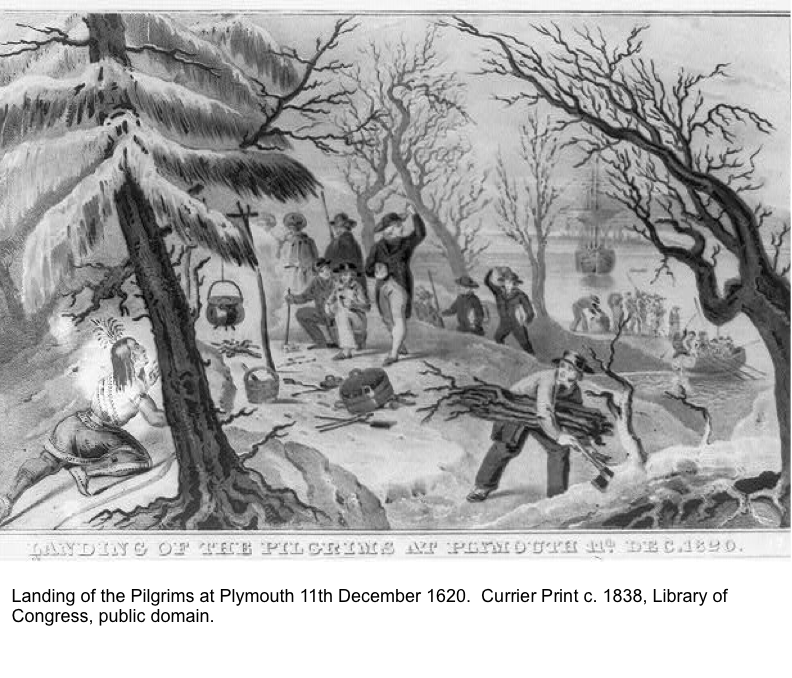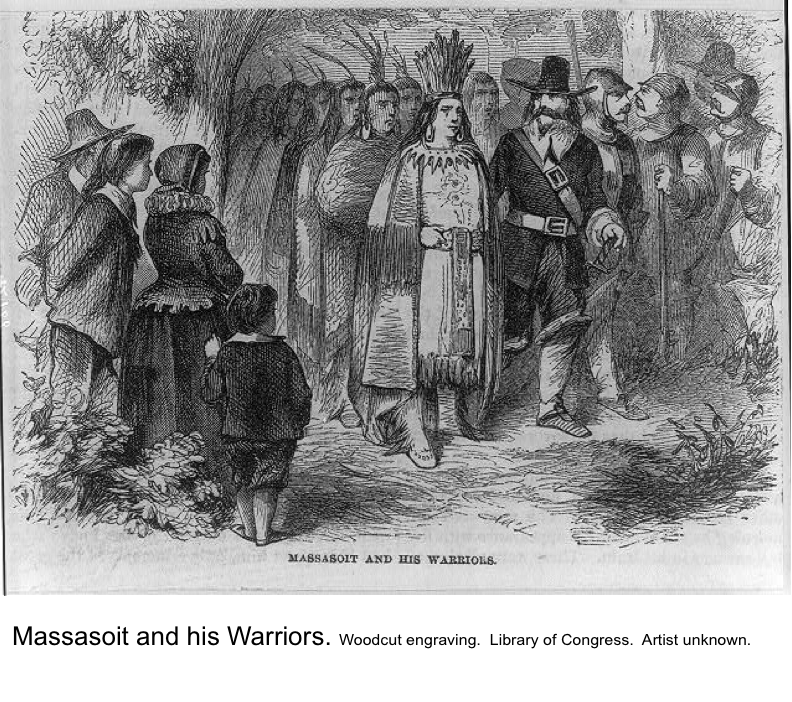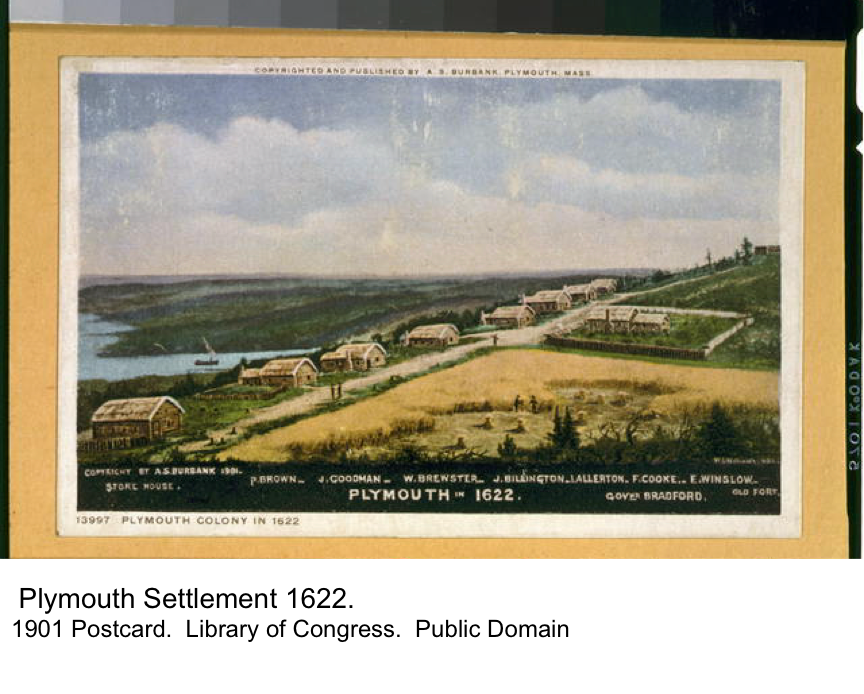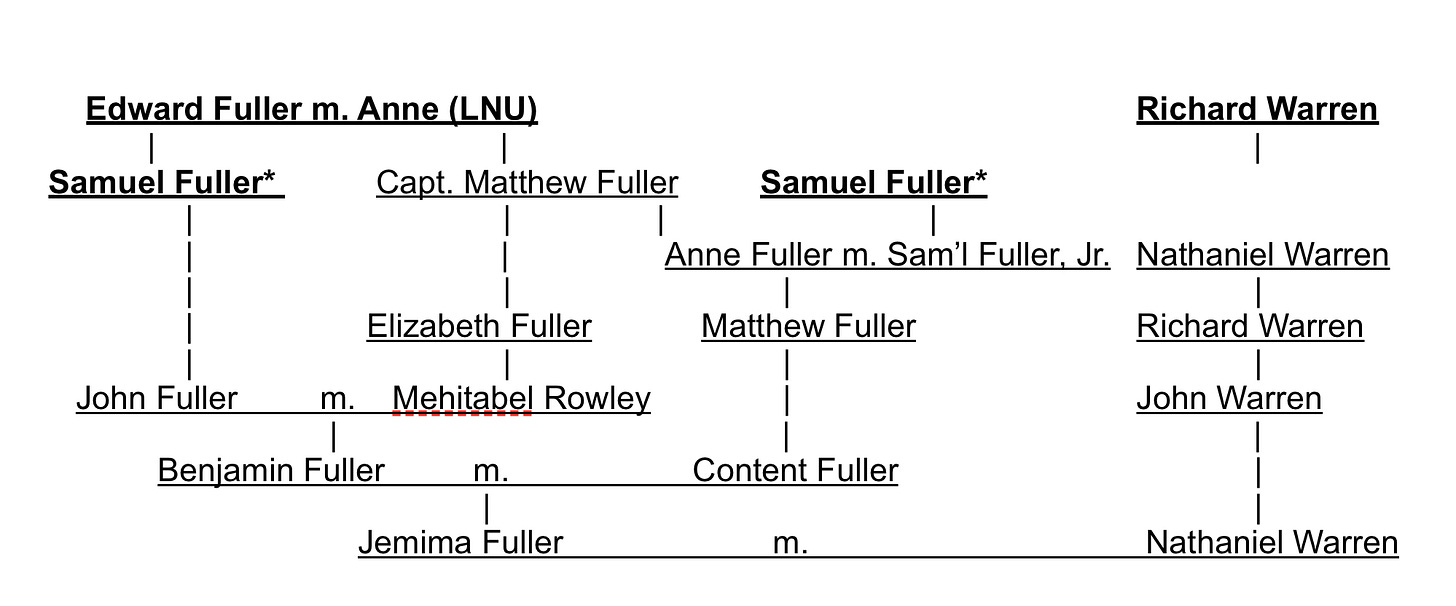European Origins - The Great Migration Begins
The English King Henry the VIII was born in 1491, a year before Christopher Columbus crossed the Atlantic Ocean to America. It was in part the actions of Henry VIII that eventually led our first immigrant ancestors to leave Europe for America in 1620. When the Pope refused to permit Henry to divorce his first wife, Catherine of Aragon, Henry decided to start his own church. He named himself the head of this church. This new church, the Church of England, was very similar to the Roman Catholic Church. Both churches believed that the power came from God to the King and from God to the Pope. This religion empowered the ruler, Henry VIII, to demand obedience from the people. In spite of the similarities between the religions, there still were a series of English wars between the Catholics and the Church of England.
The invention of the printing press put the Bible in the hands of the common people. As the common folk read the Bible they began to question those in authority. The Protestant Reformation in the 16th Century was the result. The Protestants believed that the power did not have to go through the Pope or the King. The Protestant Reformation began with Martin Luther in Germany in 1517. While our ancestors were mostly Protestants, they were of many different types. The name “Protestants” means that these people “protested” the ideas of the Catholic Church, which until the time of Luther was the only Christian Church. The main idea of the Protestants was that an individual could approach God directly without going through a priest or the Pope. It was the ability to read, coupled with the power of logical thinking, that drove the Protestants to question the power of popes, priests and kings.
John Calvin (1509-1564) broke from the Roman Catholic Church about 1530. He fled to Switzerland and established a reform movement. By 1541 Geneva was basically a theocracy. Even though Calvin’s theology called for a separation between Church and State, the Council that was established wielded enormous power over the daily lives of the citizens. As Voltaire stated, when writing about Calvin, Luther and Zwingli:
"If they condemned celibacy in the priests, and opened the gates of the convents, it was only to turn all society into a convent. Shows and entertainments were expressly forbidden by their religion; and for more than two hundred years there was not a single musical instrument allowed in the city of Geneva. They condemned auricular confession, but they enjoined a public one; and in Switzerland, Scotland, and Geneva it was performed the same as penance.”
It was into this strict environment that Samuel Fuller was born about 1608 in Egerton, Kent, England, England. His parents were Edward and Anne Fuller. His brother Matthew was about 3 years older, born in 1605. Both Samuel and Matthew are our ancestors. Samuel’s father Edward and his mother Anne were both members of an illegal Congregational Church in England that met secretly in people’s homes. The Church of England believed that power came from God to the King to the Minister of the Church. But the Congregational Churches believed that the people in the congregation could select their own Minister because the power came from God directly to the congregation. The Pilgrims at that time were called “Separatists” because they wanted to separate from the Church of England. These Separatists were later called “Pilgrims.” Other congregationalists were called “Puritans” because they wanted to “purify” the Church of England from practices which they believed were wrong, while not separating from the Church of England.
Congregationalism was a very radical idea in 1612. The Church of England and the Catholic Church both wanted to keep the power away from the people in the congregations. So both the Catholics and the Church of England were against the Congregationalists. Laws were passed which made it illegal to go to any church except the Church of England, forcing the Congregationalists to meet secretly in homes. Some of the Congregationalists left England and moved to Holland so they wouldn’t have to practice their religion in secret.
Samuel and Matthew Fuller moved with their parents to Holland in 1612 or 1613. They first lived in Amsterdam then moved to Leyden, Holland. Samuel and all of the Pilgrim children were taught to read. It was important for children to read because they believed that each person was responsible to learn on their own and decide for themselves what was true. They believed that a person should not just listen to the priest and obey. Rather each person had a duty and obligation to decide for themselves what was true and what was false.
In Holland the children began to play with other Dutch children and learn the Dutch language. The English parents were afraid their children would become Dutch and lose their identity. No doubt they also lacked economic opportunities because they were foreigners.
Finally the Pilgrims in Holland decided to start a colony in the New World. They obtained a patent to settle near the Hudson River in present day New York. They arranged for two ships, hoping to leave England in July. But a series of mishaps, some of which were most likely intentional, repeatedly delayed their departure. It was not until September 6, 1620 that the Mayflower finally departed. By this time they had consumed much of their supplies.
Four of our ancestors arrived on the Mayflower. They included Edward Fuller, his wife Ann, and their son Samuel. Ed and Ann’s older son, Matthew Fuller, age 15, stayed in England in order that he could complete his education. Matthew would come to Plymouth Colony twenty years later, bringing his wife and children.
Also on board the Mayflower was Dr. Samuel Fuller, the brother of Edward Fuller and the uncle of young Samuel Fuller. Dr. Samuel Fuller left his wife Bridget Lee Fuller and one child behind as well. Bridget Lee Fuller would come over to Plymouth Colony on the ship Anne in 1623. Although we are not directly descended from him, he would be an important person in the life of the new Colony and in the survival of our line.
The fourth of our ancestors on the Mayflower was Richard Warren. His wife Elizabeth Walker also stayed behind in England. She and their five daughters would also arrive in 1623 on the ship Anne.
Mayflower passengers in bold. Jemima Fuller and Nathaniel Warren in italics listed twice for clarity:
The Warren and Fuller lines would merge with the marriage of Jemima Fuller and Nathaniel Warren. They are my 6th great grandparents.
The Pilgrims first sighted North America on November 9th, 1620. But rather than Manhattan, they identified their landfall as Cape Cod, far away from where their patent was granted. They tried to sail further south and west, but bad weather, difficult seas, and deteriorating conditions on board caused them to double back. On November 11th, 1620 they sent a scouting party ashore near Provincetown, at the tip of Cape Cod. Before leaving the ship the adult male Pilgrims signed the Mayflower Compact, an agreement among themselves that outlined how they would operate the colony. Signing the Mayflower Compact were our ancestors Edward Fuller and Richard Warren.
The explorations of Cape Cod were not promising, although they did find and steal some Indian corn that had been stored by the Indians. The Pilgrims spent the next six weeks exploring Cape Cod and the westerly reaches of the Bay. Finally on December 25, 1620, they decided upon Plymouth as the site of their colony and began construction of the first buildings.
Both Edward and Anne died within a few months of arriving at Plymouth, Massachusetts. After his parents died, young Samuel moved in with his uncle, Dr. Samuel Fuller. Only half of the 102 people on the Mayflower survived the first year. They subsisted by hunting, fishing, robbing Indian stores, and eating the meager supplies from the ship. They stole corn that the Indians had preserved in woven baskets and bags buried for their future use.
The Pilgrims settled into an area that had been abandoned because of an epidemic that wiped out most of the Wampanoag Indian tribe. Whole villages were depopulated in 1618-1619. In the Spring of 1621, Massasoit, the Wampanoag Indian Chief who ruled the region, visited the Pilgrims.
As we have learned, by the time of the Mayflower arrival in North America, diseases brought by the earlier explorers had already spread throughout the continent, decimating the population. Because Massasoit’s Wampanoag tribe had been so severely reduced in size from disease, he decided to permit them to remain instead of killing them, which his warriors could easily have done. By accepting the Pilgrims into his area, Massasoit hoped to obtain some help against his longtime enemies, the Narragansett alliance, who lived in the Connecticut River Valley just to the west and south.
Above: Massasoit and Governor Carver smoking a peace pipe, Plymouth Colony 1621, Artist unknown, The Sutro Library, San Francisco, California. Public Domain.
In the Spring of 1621 Massasoit gave the Pilgrims seed corn, a crop that was new to the Pilgrims. He also loaned them the Indian Tisquantum, an English speaker also known as Squanto, to help them survive. Massasoit did not fully trust Squanto, so he sent the Indian Hobamok to monitor the situation. With the help and guidance of Squanto and Hobamok, the Pilgrims were able to plant a crop in the Spring of 1621.
As the days shortened and the nights became cooler in the autumn of 1621 the Pilgrims saw, for the first time, the bright reds and oranges of New England’s forests. The trees in Europe do not turn orange or red, and so they were amazed by the brilliance of the trees in their new home. They celebrated their survival and harvest with a feast, the first Thanksgiving. Two of our ancestors were there at this first Thanksgiving: young Samuel Fuller and Richard Warren. They celebrated their harvest and survival with their Indian allies. Turkey, oysters, fish, venison, corn porridge and other game were part of the three-day feast. Without the assistance and cooperation of the Indians it is highly likely that the Colony would have perished.
We don’t know how young Samuel felt at this first Thanksgiving because he left no record. His parents had both been gone for almost a year. He would have found himself on the edge of a continent that was largely unexplored, with no towns, schools, stores, and very few people who spoke his language.
In 1623 young Samuel was given three acres of land during the Land Division. We believe that Samuel received three acres instead of one because he received an acre for each of his parents, as well as one acre for himself. The land assigned to young Samuel was on the south side of the Plymouth town brook, and included what is now Watson’s Hill. The Wampanoag Indian Hobamok lived next door.
Dr. Samuel Fuller, young Samuel’s uncle and brother to Edward, was an important person in the early colony. He came alone on the Mayflower, leaving his wife and children behind. After the deaths of Edward and Anne, Dr. Fuller took in young Samuel and sent money to Samuel’s brother, Matthew, who had remained behind in England. Dr. Fuller’s wife and daughter would join him in 1623 when the ship Anne arrived. Dr. Samuel Fuller was the physician and surgeon for the community, the first doctor in New England.
Also on the Anne was our ancestor Elizabeth Warren, wife of Richard Warren, and their five daughters. Within a year they would have a son, our ancestor Nathaniel Warren, born 1624, the first of our ancestors to be born in the New World. Nathaniel Warren would have a great grandson, also named Nathaniel Warren, who would marry Jemima Fuller, the great granddaughter of young Samuel Fuller.
The Fuller line is more a family bush than a tree. Here is a simplified version with those on the Mayflower in bold. Samuel and Capt. Matthew Fuller are brothers as are John Fuller and Samuel Fuller, Jr.. Anne Fuller and Elizabeth Fuller were sisters. Anne Fuller and Samuel Fuller Jr. were first cousins. Samuel Fuller* is listed twice. Nathaniel Warren is the great great grandson of Mayflower passenger Richard Warren:
We cannot really fault these early settlers for marrying their cousins as there were very few marriage options available. In 1633 a terrible smallpox and influenza epidemic swept along the St. Lawrence River, down the Connecticut River, and west as far as the Hurons. Entire Indian villages were wiped out, depopulating the Connecticut River Valley even more. Twenty Plymouth colonists also died, including their only physician, Dr. Samuel Fuller. The population of Plymouth Colony in 1634 has been estimated at 350-400 people. This would mean that more than 5% of the population of the Colony died from this epidemic. Smallpox would continue to threaten the people of New England for more than a century until the discovery and acceptance of vaccination.
In 1634, following the death of his uncle, Dr. Samuel Fuller, young Samuel became a “Freeman.” Any man entering a colony was initially not considered “free.” He was not forced to work, but his movements were carefully observed to see if they followed the Puritanical ideal. After this probationary period, he became a "Freeman." Such men would then take the Oath of a Freeman, vowing to defend the Commonwealth and not to overthrow the government. The Colony was governed by a General Court, who acted very much like the Council established by Calvin in Geneva.
That same year he became a freeman, 1634, Samuel Fuller moved to Scituate, a settlement in Plymouth Colony about 20 miles north of the original settlement, perhaps because of the arrival in Scituate of a young lady, Jane Lothrop. At about this same time, twenty-year old Jane arrived on the ship Griffin with her parents, Rev. John Lothrop and Hannah Howse. Jane was born in September, 1614 in Edgerton, Kent County, England. They initially settled in Scituate.
The Griffin had left England August 1, 1634 and arrived in Boston on September 18, 1634 with about one hundred passengers and cattle for the plantations. The passengers included the Bartholomew, Cotton, Hammond, Haines, Heaton, Hutchinson (including dissident Anne Hutchinson), Lothrop, Lynde, Magatt, and Symmes families.
Less than six months after the arrival of the Griffin, on April 8, 1635 at Scituate, Captain Miles Standish officiated at the marriage of Jane Lothrop and Samuel Fuller. Captain Miles Standish was the civil leader of the Plymouth Colony. The Pilgrims believed that marriages were civil, not religious, and kept the Church out of the marriage process. Jane was then 20 years old, while husband Samuel was about 25 years of age.
In November 7, 1636 Samuel Fuller joined the church in Scituate, where his father in law was the minister. In that year Samuel and Jane built the fifteenth house in Scituate on Greenfield Street. They owned twenty acres there on the east of Bellhouse Neck. Jane's father Rev. Lothrop called the houses built by the early settlers “small plaine pallizadse Houses." The walls were made of poles that were filled between with stones and clay. They had thatched roofs. The lower part of the chimneys were made of stone and above that they were built of logs. Windows had oiled paper instead of glass, and the floors were made of hand sawn wooden planks.
Reverend John Lothrop and family history
By the time Jane Lothrop landed in North America in 1634 at the age of 20, she had experienced the imprisonment of her father and the death of her mother. Jane’s father, Rev. John Lothrop, was baptized as a child at Etton, Yorkshire County on December 20, 1584. He was raised in Oxford and educated at Queen's College, Cambridge. He received his B. A. in 1605, and M. A. in 1609. He was of course a member of the Church of England.
Rev. Lothrop married Hannah Howse on October 10, 1610. He became curate of the parish church in Edgerton, County of Kent about 1611. As mentioned, Jane was born in 1614 and was also baptized into the Church of England. In 1623 Rev. Lothrop left the Church of England and subscribed to the doctrines of the Independents. In 1624 he was called to be pastor of the First Independent Church in London. These “Independents” were also Congregationalists.
The Independents were forced to meet in private to avoid the scrutiny of the Bishop of London, William Laud. On 22 April 1632 officers of the King burst in on a church service of the Independents. John Lothrop and forty-one of his parish Independents were arrested. Eighteen escaped capture. The arrested were prosecuted for failure to take the oath of loyalty to the Church of England. John Lothrop was sent to jail in either the Clink or Newgate Prison, and may actually have served time in both prisons. After about a year, all were released on bail except Lothrop, who as their leader was deemed too dangerous to be set at liberty.
During the years John Lothrop was in prison, his wife Hannah House became ill and died. His six surviving children, including our ancestor Jane, were left to fend for themselves. They begged for bread on the streets of London. John Lothrop, being in prison, was unable to care for his children. His friends presented the children to the Bishop who had charge of Lothrop and asked the Bishop to explain who was to care for these children. Finally the Bishop ordered the release of Lothrop on bond in May 1634 with the understanding that he would immediately leave with his family for the New World.
John Lothrop was told that he would be pardoned upon acceptance of terms to leave England permanently with his family along with as many of his congregation members as he could take who would not accept the authority of the Church of England. Lothrop accepted the terms of the offer and left for Plymouth, Massachusetts. When he arrived at Plymouth Colony on the Griffin, John Lothrop publicly rejoiced in finding a "church without a bishop and a state without a king.”
Note from the EDITOR: To gain a unique perspective and an important view of the Plymouth settlement from the Wampanoag perspective, watch Our Story: 400 years of Wampanoag History, You Tube.
Footnotes for this Chapter:
Voltaire, 1694–1778. "The works of Voltaire : VOLUME XXVII. ANCIENT AND MODERN HISTORY.4 . CHARLES V., 1512—PHILIP II., 1584"
I have chosen to use the term “Indians” rather than “Native Americans”, “Amerindians”, or some other nomenclature for several reasons, all spelled out in detail by Charles Mann in his best selling seminal work, 1491: New Revelations of the Americas Before Columbus, Appendix A: Loaded Words; 2006, Knopf.
The Puritans are often confused with the Pilgrims. The Puritans still recognized the Church of England. They settled in the Boston area in 1630 when 17 ships carrying more than 1000 passengers started the Massachusetts Bay Colony. We are also descended from some Puritans, but the Pilgrims came first.
Each person listed in the family trees in this book is one of our grandparents. For example, Edward Fuller and his wife Ann LNU (last name unknown) and Richard Warren and his wife Elizabeth Walker each are my tenth great grandparents. Similarly, Jemima Fuller and Nathaniel Warren are my sixth great grandparents. So any names listed on the family trees are direct ancestor-grandparents.
It is highly likely that the Dutch had conspired with the Mayflower skipper to take the Pilgrims to Cape Cod. The Dutch themselves had great hopes to colonize the area covered by the Pilgrim’s patent, which they did, successfully establishing New Amsterdam on the tip of Manhattan in 1624.
Charles Mann, 1491: New Revelations of the Americas Before Columbus, 2006, p. 57
Corn had been domesticated by the early ancient farmers of Mexico.
Richard Warren’s wife and children had not yet arrived. Young Samuel Fuller’s parents had died in early 1621 and his brother Matthew was still in England. So only our direct ancestors at this first feast were Richard Warren and young Samuel Fuller.
The Land Division “In the beginning, the financial agreement with the colony’s backers called for property to be held in common. While the colonists owned their personal possessions, the houses, land and livestock belonged to the company as a whole for the first seven years. In 1621 and 1622, the men planted and tended the common fields, and the harvest was rationed out to the households. This did not give them the results they needed for several reasons. Those who were stronger disliked receiving no more than those who were weak and not able to do a quarter of the work. Single men resented working to support other men’s families. Those who were “aged and graver” felt that being treated equally with the younger was disrespectful to them. In 1623, Governor Bradford determined that each family, and the young men placed under them, would receive a parcel of land, an acre apiece, to farm themselves. They would have to turn in a portion of their harvest for common use, but would keep the remainder. This pleased all sides and more corn was planted than Bradford felt would have been done under any other plan. Fortunately for Plymouth Colony researchers, a list was drawn up at that time portioning out the land. Each ship’s company was allotted land in specific sections, providing rough lists of passengers for the Mayflower, Fortune and Anne (which included the Little James). Most of the colonists were grouped under their head of household, unless the family members had come on different ships. Some of the acres, particularly for the Mayflower, were assigned to people who had died, perhaps accounting for shares they had held. The resultant list provides our best knowledge for Plymouth’s population at that time.” https://www.plimoth.org/sites/default/files/media/pdf/historical_key_docs.pdf
Hobamok, or Hobbamock, was a Wampanoag Indian. He was an important friend and ally of the colonists, and a friend and sometime rival of Squanto. He died in 1642 of a European disease contracted from his close European friends.
Nathaniel Philbrick, Mayflower: A Story of Courage, Community, and War, Viking Press, 2006.
Calloway, Dawnland Encounters: Indians and Europeans in Northern New England, University Press of New England, 2000
Stratton, Plymouth Colony: Its History & People 1620-1691, Ancestry Publishing, 1986, p. 50
It can be confusing to research Samuel. His uncle Dr. Samuel Fuller also had a son named Samuel, referred to sometimes as Samuel Fuller, Jr. Even more confusing, Samuel Fuller and Jane Lothrop Fuller had a son also called Samuel Fuller, Jr. Contrary to some, our Samuel, although mentioned in his uncle’s will as an alternate beneficiary, was not the executor of his uncle’s estate and did not inherit anything from his uncle, although he was named an alternate beneficiary should Dr. Fuller die without children.
By the Plymouth Laws of 1636, every freeman was required to take the following Oath. The oath that Samuel took in 1634 was no doubt very similar:
The Oath of a Freeman
You shall be truly loyall to our Sov Lord King Charles, his heires & successors, You shall not speake or doe, devise or advise any thing or things act or acts directly or indirectly by land or water, that doth shall or may tend to the destrucc̄on or overthrow of this pr̄nt plantac̄ons Colonies or Corporac̄on of New Plymouth, Neither shall you suffer the same to be spoken or done but shall hinder oppose & discover the same to the Govr̄ & Assistants of the said Colony for the time being or some one of them. You shall faithfully submit unto such good & wholesome laws & ordnanc & as either are or shall be made for the ordering & governmt of the same, and shall endeavor to advance the growth & good of the severall Colonies plantations wth in the limit & of this Corporac̄on by all due meanes & courses. All wch you promise & sweare by the name of the great God of heaven & earth simply truly & faithfully to pforme as you hope for help frō God who is the God of truth & punisher of falsehood. [1636]
Following the outbreak of civil war in England in 1638, the words “our sovereign lord King Charles his heirs and successors” were erased, and loyalty to “the State and Government of England as it now stands” substituted.
David Hall in The Legacy of John Calvin: His Influence in the Modern World rightly stated that “citizens on both sides of the Atlantic believed that the intellectual descendants of Calvin were the founders of colonial America.” David Hall, The Legacy of John Calvin: His Influence in the Modern World (Phillipsburg, NJ: P&R Publishing, 2008), p. 111.
A plaque in the Lothrop Hill Cemetery in Barnstable, Massachusetts, the town which John Lothrop settled and where he died, states he was incarcerated in Newgate Prison during the years 1632-1634. The National Archives at London which would hold the records for Newgate Prison indicate they have nothing earlier than 1770. The lack of documentation is attributable to the Great London Fire (1666), the Gordon Riots (1780), and the fact that upon the abolition of the Star Chamber in 1641, the court proceedings of the reign of Charles I deteriorated and failed to survive. A report to the Lords in 1719 noted that those documents were "in a very great heap, undigested, and without any covering from dust or security from rats and mice." As for records of the Clink, the National Archives indicates they would be held at the London Metropolitan Archives, but those records start from 1690. The National Archives states that records from these earlier times are also not complete due to the fact that they were not created or kept for research purposes, but for use by the government or law courts of the day.
See, Governor Winthrop's Journal, p. 71.
The First Settlers in Barnstable, Amos Otis, 1888.
Besides our line, six U.S. Presidents are descended from Rev. John Lothrop, including the Bushes, Millard Fillmore, James Garfield, U.S. Grant and Franklin D. Roosevelt. Other descendants include Benedict Arnold, Joseph Smith (founder of the Mormon religion), George and Mitt Romney, Sarah Palin, Sen. Adlai Stevenson III, CIA Director Allen W. Dulles, Secretary of State John Foster Dulles, Wild Bill Hickock, Henry Wadsworth Longfellow, Benjamin Spock, Georgia O’Keeffe, Oliver Wendell Holmes, C.W. Post, John Pierpont Morgan, Clint Eastwood, and many others.



